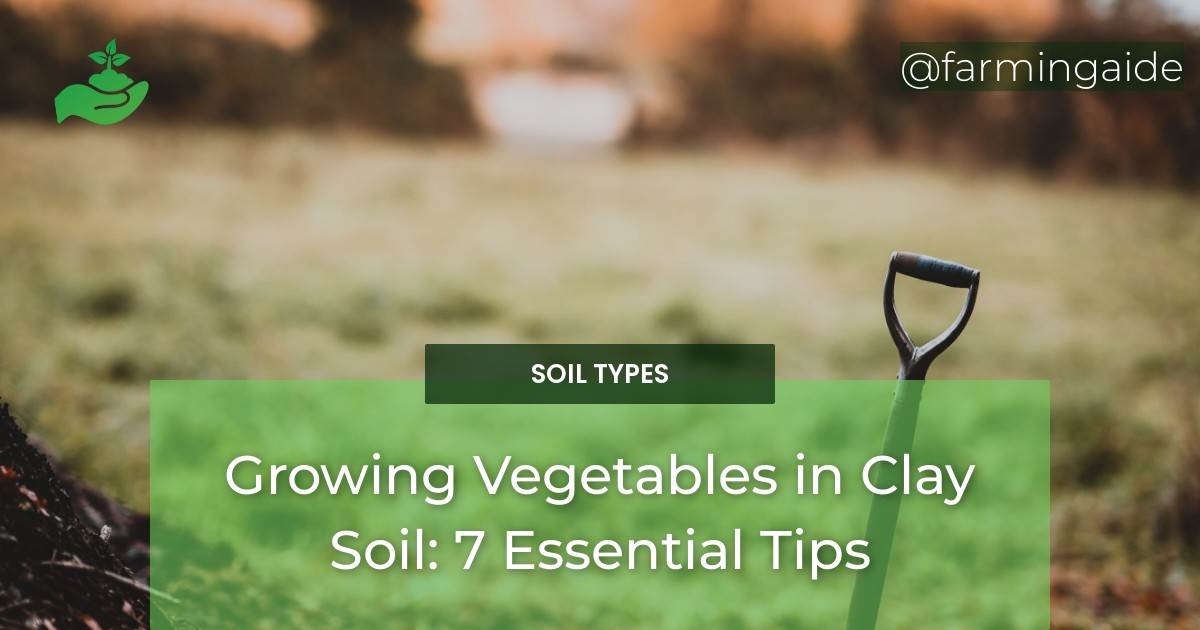Are you struggling to grow vegetables in clay soil? Don’t worry, you’re not alone. Clay soil, with its heavy texture and poor drainage, can present challenges for gardeners. However, with the right techniques and tips, you can successfully cultivate a thriving vegetable garden in clay soil. In this article, we will explore the importance of drainage and raised beds in clay soil, and provide you with seven essential tips for Growing Vegetables in Clay Soil and in these conditions.
Table of Contents
Importance of Drainage in Clay Soil
Ensuring Proper Drainage for Vegetable Growth
One of the key factors for successful vegetable gardening in clay soil is ensuring proper drainage. Clay soil tends to hold water and can become waterlogged, which can lead to root rot and other problems for your plants. To improve drainage, consider implementing the following techniques:
1. Amending the Soil with Organic Matter
Adding organic matter, such as compost or well-rotted manure, can help improve the structure of clay soil and increase its ability to drain excess water.
2. Using Raised Beds
Raised beds are a great solution for growing vegetables in clay soil. By elevating the planting area, you can create better drainage and prevent water from pooling around the roots of your plants.
Essential Tips for Growing Vegetables in Clay Soil
Adding Amendments to Improve Clay Soil
Amending clay soil with organic matter is essential for improving its overall quality and fertility. Here are a few key tips for adding amendments:
1. Organic Matter as a Key Amendment
Organic matter, such as compost, leaf mold, or well-rotted manure, provides essential nutrients and improves the structure of clay soil. Aim to incorporate at least 3-4 inches of organic matter into the top 6-8 inches of soil.
2. Using Compost to Improve Soil Structure
Compost is a valuable amendment for clay soil as it helps break up compacted soil, improves drainage, and enhances soil fertility. Apply a layer of compost on the soil surface and gently incorporate it into the topsoil using a garden fork or tiller.
Managing pH Levels in Clay Soil
The pH level of your soil plays a crucial role in the availability of nutrients to your vegetable plants. Here’s how you can manage pH levels in clay soil:
1. Testing Soil pH and Adjusting if Necessary
Use a soil testing kit to determine the pH level of your clay soil. Most vegetables thrive in slightly acidic to neutral soil with a pH range of 6.0-7.0. If the pH is too acidic, you can add lime to raise the pH level, or if it’s too alkaline, you can amend with organic matter or sulfur to lower the pH.
Ensuring Proper Aeration in Clay Soil
Air circulation is important for the health of the roots and overall plant growth. Try these techniques to improve soil aeration in clay soil:
1. Incorporating Organic Matter
Adding organic matter to clay soil helps create pore spaces, allowing air to penetrate and reach the roots. Mix in compost, peat moss, or other organic materials to promote better aeration.
2. Avoiding Overwatering
Clay soil already retains moisture well, so avoid overwatering your plants. Excessive water can lead to waterlogged soil and reduce the availability of oxygen to the roots.
Utilizing Mulch for Moisture Retention
Mulching is a beneficial practice for retaining moisture, controlling temperature, and suppressing weeds. Consider the following when using mulch in clay soil:
1. Types of Mulch Suitable for Clay Soil
Choose organic mulches like straw, shredded leaves, or wood chips that will break down over time and contribute organic matter to the soil. These materials also help improve soil structure and drainage.
2. Applying Mulch to Retain Moisture and Control Temperature
Apply a layer of mulch around your vegetable plants to conserve moisture and regulate soil temperature. Mulch also acts as a barrier against weed growth, reducing competition for nutrients and water.
Can Raised Bed Gardening Help with Growing Vegetables in Clay Soil?
Raised bed gardening tips can definitely help with growing vegetables in clay soil. By building raised beds, you can control the quality of the soil and ensure proper drainage, which is crucial for vegetables to thrive. Adding compost and organic matter can also improve the soil structure for better plant growth.
Additional Considerations for Growing Vegetables in Clay Soil
Choosing the Right Vegetables for Clay Soil
Not all vegetables are well-suited for clay soil. Selecting the right vegetables can significantly improve your chances of success. Consider these factors when choosing vegetables:
Proper Irrigation Techniques for Clay Soil
Watering plays a crucial role in vegetable gardening. Follow these guidelines for proper irrigation in clay soil:
Implementing Crop Rotation in Clay Soil
Crop rotation is an essential practice for maintaining soil health and preventing diseases and pests. Here’s how you can implement crop rotation effectively in clay soil:
By implementing these seven essential tips and considering additional factors, you can overcome the challenges of gardening in clay soil and enjoy a bountiful vegetable harvest. With proper drainage, soil amendments, and careful plant selection, your clay soil garden can thrive beyond your expectations.
RELATED ARTICLES:


